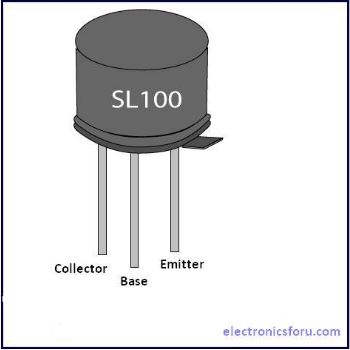Transistors are the basic building blocks of integrated circuits (IC). Every electronic gadget you can possibly imagine today uses transistors. The development started off with vacuum tubes and lead to the transistor as the BJT we see today. A bipolar junction transistor (BJT) is a type of transistor that uses both electron and hole as charge carriers. BJTs can be classified into two types, NPN and PNP transistors. An NPN transistor consists of layer of p-doped semiconductor between two n-doped layers. Whereas a PNP transistor consists of n-doped semiconductor between two p-doped layers. The most common example in usage being the SL100 transistor.
Sl100 transistor is a general purpose, medium power NPN transistor. Being a general purpose transistor makes the SL100 transistor open to a wide spectrum of electronic applications. Major applications range from general switching, manufacture of logic gates, amplification and sound reproduction, radio transmission and signal processing. However, it’s generally used as a switch in common emitter configuration.
The transistor terminals require a fixed DC voltage to operate in the desired region of its characteristic curves. This is known as the biasing. SL100 transistor is biased to remain fully ON if there is a signal at its base. It is turned OFF completely in the absence of base signal.
Depending on the transistor biasing and the circuits connected to it, the transistor acts either as an amplifier or as a switch. When acting as an amplifier, the transistor can transmit or receive radio signals, perform analog mathematical calculations, generate wave-forms among other functions. When acting as a switch the circuit can turn on/off a light, motor, perform digital logic or mathematical operations, fetch and decode computer instructions and the like. The pin diagram of a typical SL100 transistor is given below.
Pin Diagram of SL100 transistor
A SL100 transistor has 3 terminals namely a collector, a base and an emitter. A protruding edge in the transistor case indicates the emitter. The base is nearest to the emitter while collector lies at the other extreme of the casing.
The datasheet for SL100 transistor is available at SL100 transistor datasheet.
SL100 transistor is very cheap and readily available in market, which fetches them wide range of applications in various circuits. A SL100 transistor is sufficient enough to construct a simple continuity tester circuit, which gives visual and audio outputs when the continuity present at the probes. Other circuits using SL100 transistors are automated water level indicator, rain detector alarm circuit. Automatic street light circuit, automatic emergency lights, beeper circuit, gas sensor alarm circuit, automatic voltage stabilizer, solar charger are also some applications.








Sorry but the SL100 is hardly a “common” NPN transistor in North America. It doesn’t exist in Digikey, Jameco, Newark, or others. AFAICT its obsolete and has been for over a decade. Are you cutting and pasting from electronics magazines from the 1960s? Try 2n3904/3906 as a generic small signal transistor.
Hi Chris,
Thank you for pointing it out. I got a similar vibe while searching for data on this one.
But the thing to be considered here is that, we aim these articles at a lot of other geographical locations as well. In a lot of engineering colleges (not the high profiled ones) in our part of the world, teachers start off transistors with the SLN100 and the SKN100, before moving them up to ICs. We build basic circuits like the single stage amplifiers, oscillators using these transistors. Once we get used to handling these safely, we move on to using Gate ICs (7400 series). It is still some time before we move onto more recent ones. Once we do, we will talk about what the engineers require at that point of time. Till then, we hope to provide engineers with the study material they want. And since you brought it up, we will look into these and will be updating some along similar lines.
I searching a transistor part no TCD 100 LS. on google but there is no data sheet so please tell me full part no of this transistor
Thank you for your wanderfull work. Can you tell me more about sl16 transistor please.
Can we use CL100 at the place of CL100 in the given circuit ????
SL100 is not available in market..